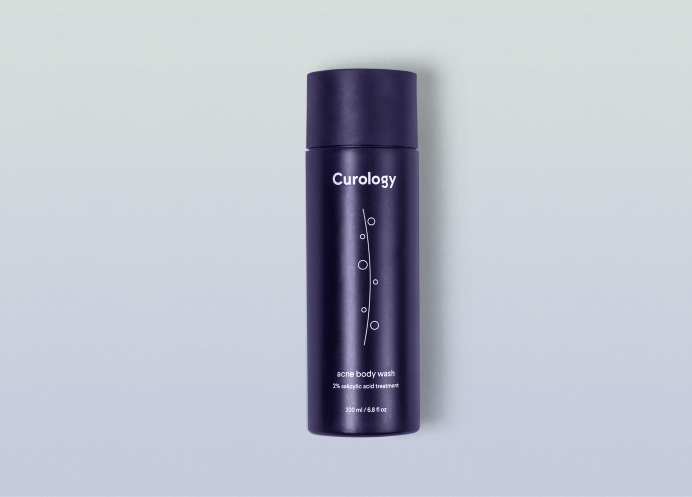How it works:
Share your skin goals and snap selfies
Your dermatology provider prescribes your formula
Apply nightly for happy, healthy skin
How it works:
How it works:
Share your skin goals and snap selfies
Your dermatology provider prescribes your formula
Apply nightly for happy, healthy skin
How it works:
How to fade dark spots on the back
Hyperpigmentation (aka dark spots) is painless and usually harmless, but there are ways to help reduce its appearance.



Ever notice uneven, dark spots or patches on your skin? You’re far from alone. Hyperpigmentation may appear on your back or elsewhere on your body and can be the result of many factors, including prolonged sun exposure or irritation or inflammation that shows up after acne or an insect bite heals. Hyperpigmentation is usually harmless, painless, and a common occurrence. It often fades with time, but there are things you can do to help accelerate the process, should you choose to do so.
Here we’ll explain how to fade dark spots on your back and other areas of your body and look at potential factors that can cause them to appear in the first place.
What is hyperpigmentation?

Hyperpigmentation is the medical term that describes areas of skin—spots or patches—that are darker than your natural skin tone. This happens when the body produces excess melanin, a substance in your body that affects skin, hair, and eye color. Melanocytes, special pigment-producing cells, are also involved in hyperpigmentation.¹ They can increase in number and increase melanin production—both leading to hyperpigmentation. UV rays, inflammation, and wound healing are all triggers that can increase melanin production and lead to dark spots or patches. While they commonly appear on the back, they can appear anywhere on the body—regardless of your skin type or skin tone.
There are many types of hyperpigmentation; two common ones are sunspots and post-inflammatory hyperpigmentation (PIH):
Sunspots (aka age spots or liver spots) are flat spots of various shapes and sizes that occur individually or in clusters. Because UV rays are the catalyst for sunspots, they are more common among people with fair skin,² and they generally happen later in life and in areas that are regularly exposed to the sun, like your face and hands. But that doesn’t mean sunspots can’t also show up on your back.
Post-inflammatory hyperpigmentation (PIH) is sometimes mistakenly referred to as acne scars, but it’s different. PIH can happen after an inflammatory blemish heals, like acne or an insect bite. It’s more common in people with darker skin tones and can be made worse by UV exposure.³
What causes dark spots?
When it comes to minimizing the appearance of dark spots, it’s important to know what causes them in the first place. Here are some examples of what may lead to dark spots:
Excessive sun exposure. UV rays are one of the more common causes of dark spots, whether from the sun or artificial tanning booths—both trigger melanin production. Remember, there’s no such thing as a healthy tan (unless it’s sunless tanner!), so be sure to always slather on the sunscreen. Liver spots or solar lentigines can develop in your skin as you age. They are dark spots from an accumulation of photodamage of the skin.
Acne. Inflammation from acne is one of the more common reasons dark spots develop on your back, chest, neck, or face.
Side effects from medication. Certain medications, like tetracyclines⁴ and chemotherapy drugs,⁵ can result in dark spots.
Medical conditions. Liver disease, Addison’s disease, and other medical conditions can also cause dark spots. If you notice hyperpigmentation on your body that changes size, shape, or color, is painful, or is accompanied by other symptoms such as a fever, it’s important to seek assistance from your medical provider as soon as possible.
What’s the best way to prevent dark spots?
Remember, everyone’s skin is unique, so the best cream to remove dark spots is one that works for you. And while we can’t guarantee that you can remove dark spots naturally, many natural ingredients can help reduce hyperpigmentation, like licorice extracts, mulberry, or turmeric.⁶ So, if you try something to remove dark spots from your body and it doesn’t quite do the job, try another treatment option. You can reduce PIH from acne by using preventative measures like Curology’s acne body wash.

Here’s what you need to know about the different treatment options with proven success in treating and preventing dark spots:⁷
Topical creams containing active ingredients like azelaic acid, niacinamide, tretinoin, kojic acid, and hydroquinone may reduce the appearance of dark spots. These work in different ways to help brighten your skin, and some, like tretinoin, work double-duty—treating acne and reducing dark spots.⁸ Hydroquinone is a skin-brightening agent that blocks tyrosinase, the enzyme that promotes melanin production.⁹ It can be an effective spot treatment.
Sunscreen is your best method for preventing dark spots in the first place. Our licensed dermatology providers recommend choosing a broad-spectrum sunscreen with SPF 30 or higher, but the best sunscreen is the one you’ll actually use. Apply sunscreen at least 15 minutes before going outside, and reapply every two hours, or after swimming, sweating, or toweling off. Use the two-finger rule to make sure you apply enough to protect your skin—and don’t forget your lips!

Chemical peels can be performed in-office by a dermatology provider or at home using exfoliating ingredients like alpha-hydroxy acids (AHAs). AHAs, like glycolic acid and lactic acid, are available over the counter and work by removing dead skin cells and boosting collagen production. AHAs may cause irritation and make your skin more sensitive to the sun, so it’s better to use these skincare products at night, followed by a rich moisturizer.
Laser treatment and intense pulsed light (IPL) therapy. Both types of devices use light to treat dark spots, but the difference between the two is what type of light is used and how it is delivered. “Lasers focus light into a narrow beam tuned to a single wavelength to penetrate the skin and help erase dark spots. IPL is a broad flash of light with many different wavelengths that penetrate into the skin,” says Whitney Tolpinrud, a board-certified dermatologist at Curology. “Lasers offer more targeted therapy; IPL can be more 'gentle,' so more treatments are often required.” Even so, both usually require multiple sessions before you notice improvement. It is possible that these treatments may worsen dark spots, so it’s important to have these procedures done by an experienced provider and review all of the potential risks and benefits of the procedure to determine if this is right for you.
Can Curology treat dark spots?
Currently, Curology can help treat hyperpigmentation on your face, and we may be able to help with back hyperpigmentation in certain cases. We can also provide you with answers to questions regarding hyperpigmentation. Your Curology membership includes a complete dermatologist-designed skincare routine delivered straight to your door—plus ongoing support from a licensed dermatology provider to help you achieve your skincare goals. Signing up is easy. Just answer a few questions and snap a few selfies to help us get to know your skin. If Curology is right for you, we’ll pair you with one of our licensed in-house medical providers, who will create a personalized prescription formula based on your unique skin and skincare goals.
Get your personalized skincare routine with Curology
Get your personalized skincare routine with Curology


Your first month is free.* Just pay $5.45 (plus tax) for shipping and handling.
FAQs
Hyperpigmentation is the medical term that describes areas of skin—spots or patches—that are darker than your natural skin tone.
Excessive sun exposure
Acne
Side effects from medication
Medical conditions
Topical creams
Sunscreen
Chemical peels
Laser treatment and intense pulsed light (IPL) therapy.
P.S. We did the homework so you don’t have to:
Wang, R.F., et al.Disorders of hyperpigmentation. Part I. Pathogenesis and clinical features of common pigmentary disorders. Journal of the American Academy of Dermatology. (2022, February 10).
Wang, R.F., et al.Disorders of hyperpigmentation. Part I. Pathogenesis and clinical features of common pigmentary disorders. Ibid.
Wang, R.F., et al.Disorders of hyperpigmentation. Part I. Pathogenesis and clinical features of common pigmentary disorders. Ibid.
Simon Nazarian, Hossein Akhondi.Minocycline.StatPearls. (2022, February 10).
National Cancer Institute.Skin and nail changes during cancer treatment. (n.d.).
Hollinger, J.C., et al.Are natural ingredients effective in the management of hyperpigmentation? A systematic review.The Journal of Clinical and Aesthetic Dermatology. (February 2018).
Nautiyal, A., et al.Management of hyperpigmentation: Current treatments and emerging therapies.Pigment Cell and Melanoma. (2021, May 17).
Dayoung Ko MD, et al.Disorders of Hyperpigmentation. Part II. Review of management and treatment options for hyperpigmentation. Journal of the American Academy of Dermatology. (2022, February 11).
Gupta, A.D., et al.The treatment of melasma: A review of clinical trials. Ibid.
* Subject to consultation. Subscription is required. Trial is 30 days. Results may vary.

Curology Team

Nicole Hangsterfer, PA-C
Related Articles
Choosing the right sunscreen: Why non-comedogenic options are a game-changer for clear skinThe 5 best chemical exfoliators for glowing skinWhich tretinoin is right for you, according to Vogue? How to help stop a rash from spreading, according to skin experts How to treat atrophic scars: Here’s what you need to knowPopular Articles
Ask Curology: Is my cold breaking me out?Slugging: The dermatologist-approved skincare hack going viral on TikTokTretinoin vs retinol: What’s the difference?How to create a self-care routine that actually sticksYour 2023 skincare horoscopeTry prescription skincare
Get routine essentials


Face what’s next with Future-ProofRx
Face what’s next with Future-ProofRx
- Skin texture
- Fine lines
- Wrinkles
- Dark spots
- Dullness
$29.95/month